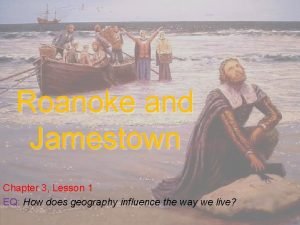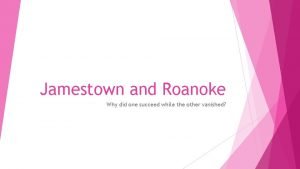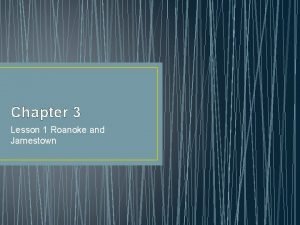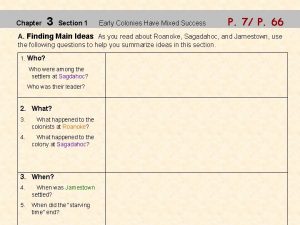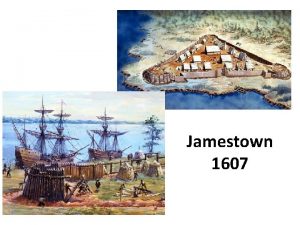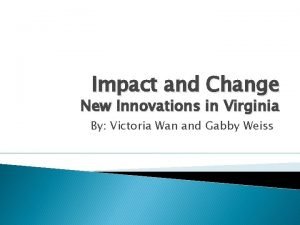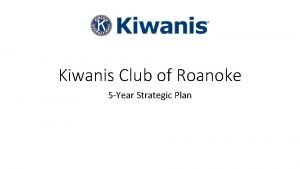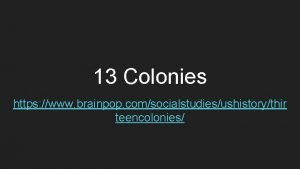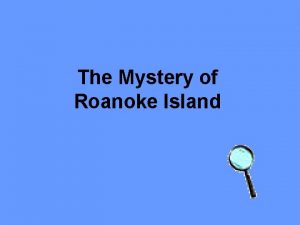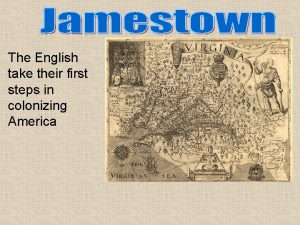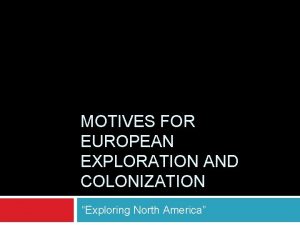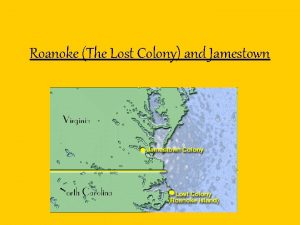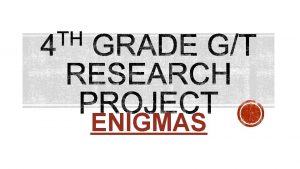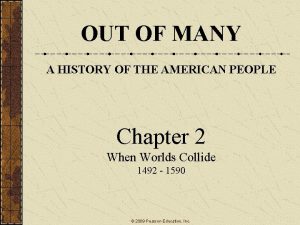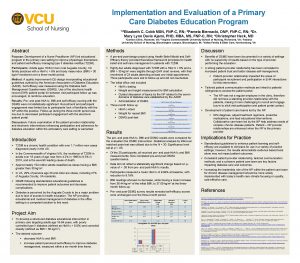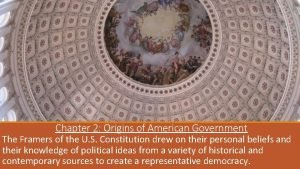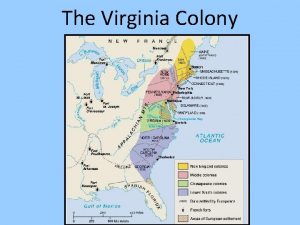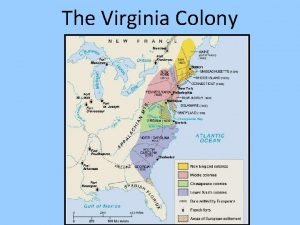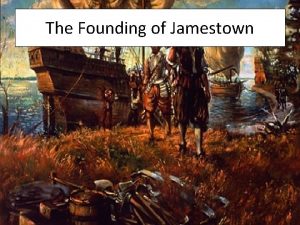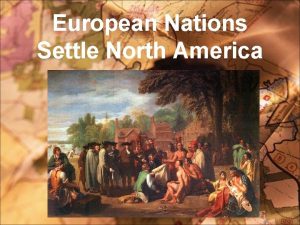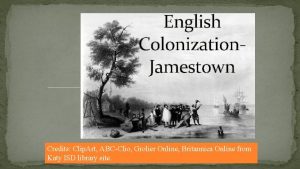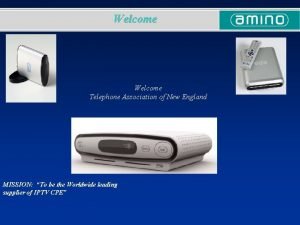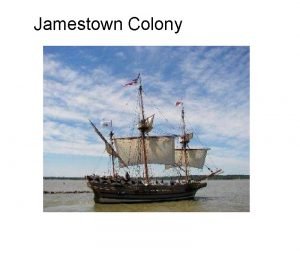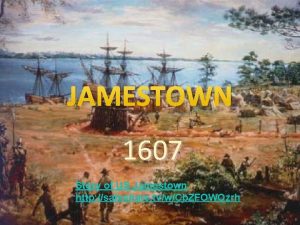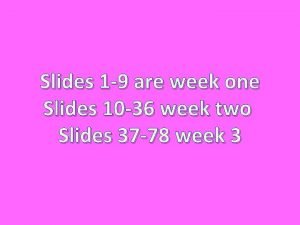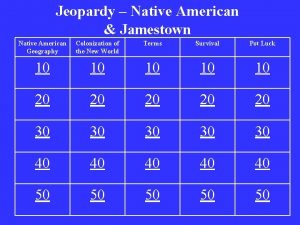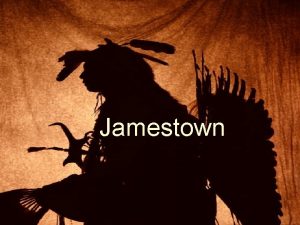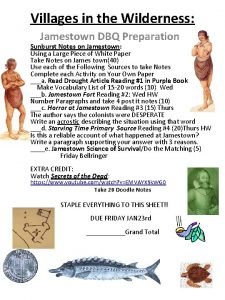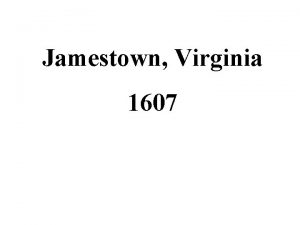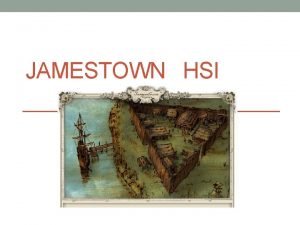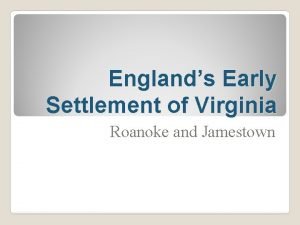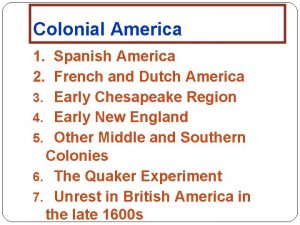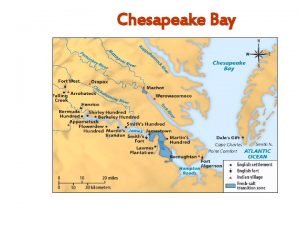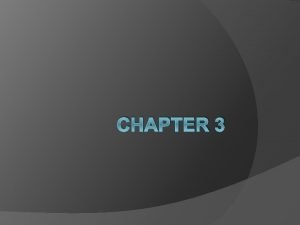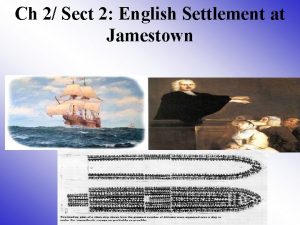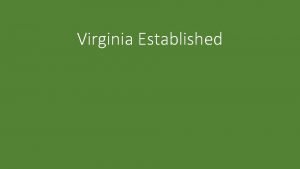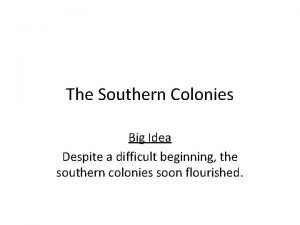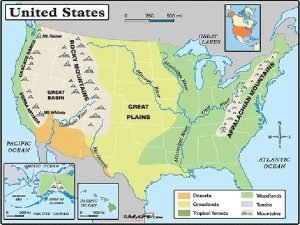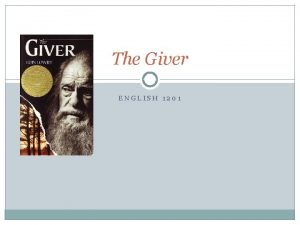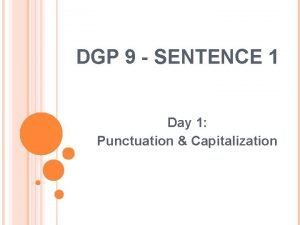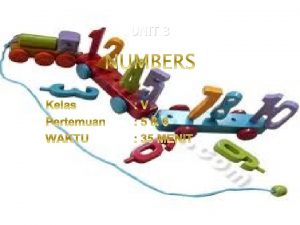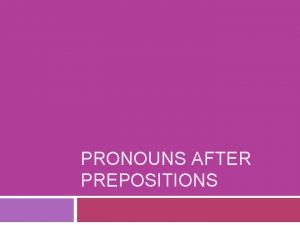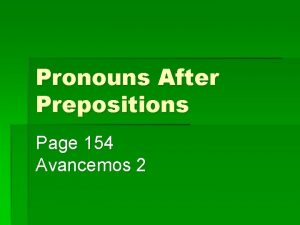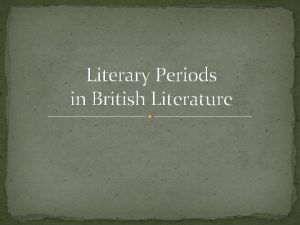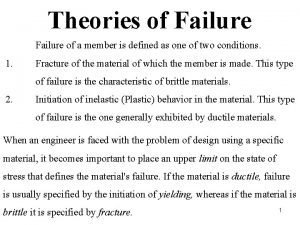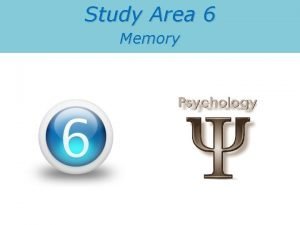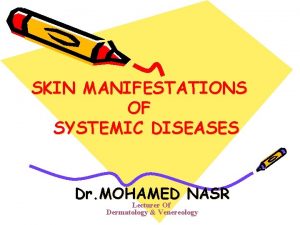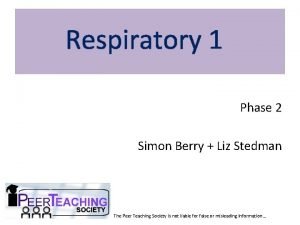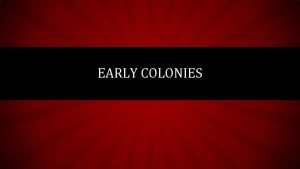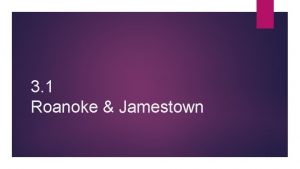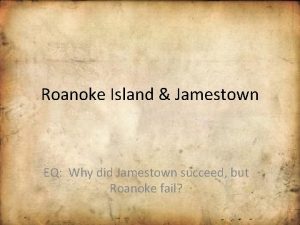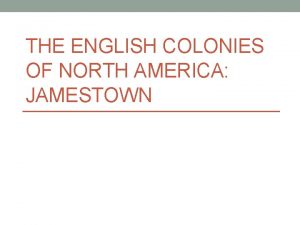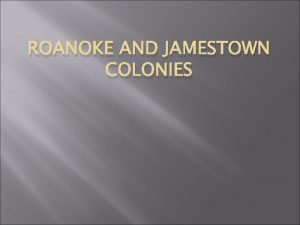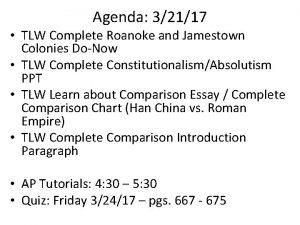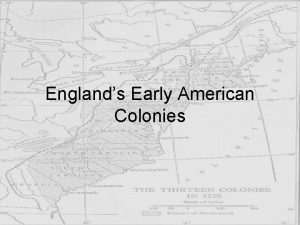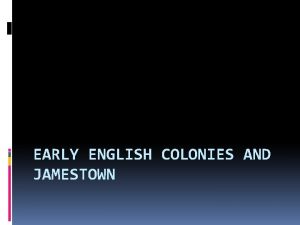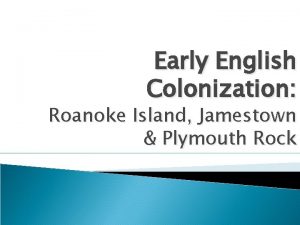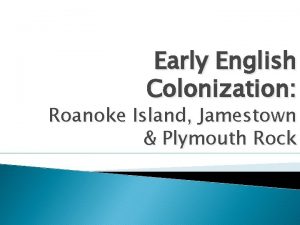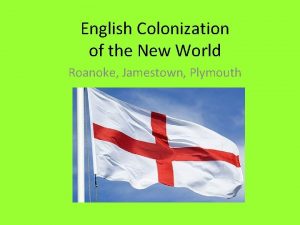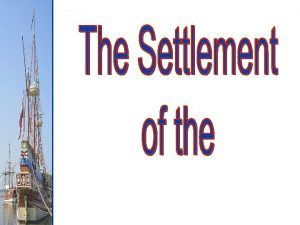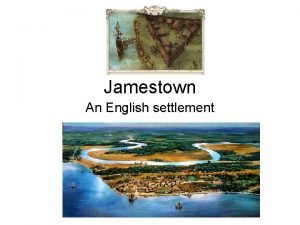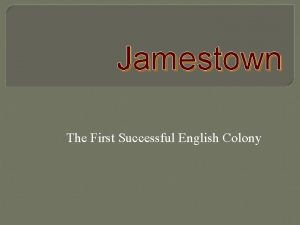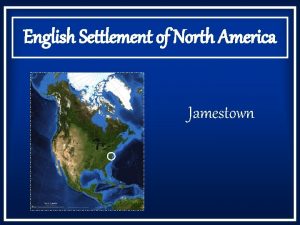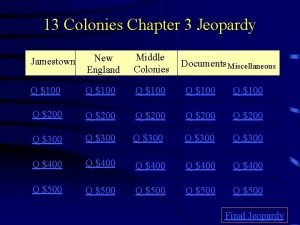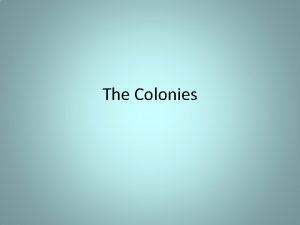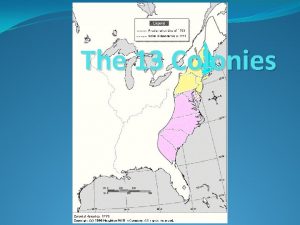English Colonies Jamestown After their failure at Roanoke






























































- Slides: 62

English Colonies

Jamestown After their failure at Roanoke, the English were not ready to give up. The English now had the most powerful navy in the world after defeating the Spanish armada in 1588 King James I wanted a colony in the new world for: GOLD GLORY

Attempt at Settlement King James I granted a charter to the Virginia Company The Virginia Company hoped to found a colony along the eastern shore where Sir Walter Raleigh had explored and claimed land for England Investors joined the expedition and would be entitled to 4/5 ths of all gold/silver they found 150 passengers left in England in 3 ships, arriving in April 1607 John Smith was their captain

Problems/Mistakes 105 men/boys were the first settlers First resupply brought 70 more men They were gentlemen, bankers, businessmen Settled on a peninsula uninhabited by the Native Americans Swampy water=mosquitoes!! Contaminated water Limited supply of animals to hunt Poor farming ground


Read- “The Starving Time” Answer the following: What problems are they facing? Why are they facing these problems? How are the problems solved?

Rather than start building shelter and planting food, they began immediately searching for gold Remember- their goal was GOLD “There was no talk, no hope, no work, but dig gold, was gold, refine gold, load gold, ” Captain Smith said of the early settlement The settlers were unaccustomed to work and refused to clear fields, plant crops, or even gather shellfish They did not encourage friendly relationships with the Indians, they wanted them to work as their slaves As a result, only 38 of the original 105 were alive by the winter of 1607 - First Starving Time

Starving Time nd (2 One) In the Spring of 1609, 600 new colonists arrived The Powhatan Indians began killing the colonists’ livestock and destroying their farms By winter, the colonists had to resort to eating roots, rats, snakes, and even show leather Of the 600, only 60 survived

“You must obey this now for a law that he that will not work shall not eat, except by sickness he be disabled. For the labors of thirty or forty honest and industrious men shall not be consumed to maintain an hundred and fifty idle loiterers. ” -Captain John Smith, quote in William Symonds, ed, . The Proceedings

Captain Smith He concentrated on survival, not searching for gold/Asia Tried to work with Powhatan and buy corn and with the help of Pocahontas he avoided war. Smith made everyone work, gentlemen or not, and he worked along with them. Divided the rations equally

Jamestown Becomes Permanent Resupply arrived in the Spring with more colonists, supplies, and new leaders who would hang colonists who neglected their work 1612 John Rolfe figured out how to grow a new strain of tobacco By 1620 Jamestown exported more than 1. 5 million pounds of “brown gold” each year Introduced the headright system- anyone who paid for their own land or another’s received 50 acres of land- this brought many settlers to America Women began arriving

House of Burgesses Held first meeting in 1619 in the church at Jamestown First form of representative government/elected assembly in the New World Had representatives elected by members of Jamestown Began tradition of selfgovernment for the colonies Continuously operatedknown today as the General Assembly of Virginia.

Laborers in Jamestown Originally tried to use the Native Americans, but this led to backlashes and war with the Natives Used Indentured Servants: In exchange for passage to North America and food/shelter, the servant agreed to a term of servitude, usually 4 -7 years. Usually from the lower classes of English society, but wanted a chance to make a new start First Africans arrived in 1619, they were originally indentured servants- they were given land their freedom Late 1600 s colonists began using slave labor

Your Turn What are the 3 most important things the colonists must do to help the colony survive? Who will do the work? What will we do to solve our immediate problem- lack of food? How can we ensure we have adequate food for the future? How can we be sure that all colonists will do their fair share of the work? How should we deal with the local Indians? What design is best for the protection against weather and enemies? In recruiting future settlers, what skills and occupations does the colony need and should be required?

Pilgrims & Puritans

Background Information Growing group in England began to disagree with the Church of England. They wanted to SEPARATE from the Church of England create their own religion. Became known as separatists Because of their beliefs, they were persecuted and discriminated against To escape the persecution, a group of separatists went to Holland to live in the countryside there Were isolated, their children were not growing up as Englishmen, couldn’t speak the language, and still suffered some discrimination

Coming to America After the relative success of Jamestown (this is 13 years later), they decided to leave Holland settle near Jamestown They would create their own colony, but close enough to Jamestown they could follow their rules and benefit from Jamestown’s success Wanted RELIGIOUS FREEDOM- the freedom to practice their beliefs without discrimination

Unexpected Changes Had to change boats before they crossed the Atlanticswitch from Speedwell to the Mayflower Got caught in a possible hurricane that blew them completely off course Considered turning around Rather than settle in Jamestown, they end up in present-day Massachusetts, and name their settlement Plymouth

As a result, they could not use the established laws and government from Jamestown, so they had to make their own Wrote the Mayflower Compact before they landed and came ashore Everyone on board agreed to the document and in the document they pledged to work for the good of the colony and abide by the agreed upon rules Government by consent Has been called the first written constitution Beginnings of American democracy

Plymouth Decide on John Carver as their first governor But dies a year later- William Bradford takes over Religious beliefs- Separatists, a form of protestants SEPARATE from the Church of England Government: Based on consent with the Mayflower compact, beginning of democracy in America Had a meeting house where the men in the colony met to discuss issues and make decisions for the colony Social structure: families lived together and had small farms, community revolved around the church



Puritans Wanted to create a model society- a “City upon a hill” Did not agree with the Church of England, they wanted to PURIFY it Known as Puritans Wanted to create a society where they could create the model for the Church of England Religious Freedom Create Massachusetts Bay Colony in 1629


Massachusetts Bay Leader: John Winthrop Religious beliefs: PURITANS- want to purify the Church of England (Anglican) Government: Made no attempt to create a democracy, but did allow more men to vote than in England- 40% could vote Created a Theocracy- The church and state were completely linked Everyone was required to go to church on Sunday, had to wear all black, no dancing was allowed, drinking, swearing, and laziness were all crimes


Social Structure Unlike Jamestown- the Virginia Company, the New England colonies (Plymouth and Massachusetts Bay) were founded for religious freedom, so more families crossed the Atlantic Their colonies were largely comprised of small families who worked together to survive There were not many indentured servants The church watched the families and stepped in parents were not strict enough or husbands and wives fought too much

Daily Life No religious freedom- if you disagreed with the Puritan church you could be punished or banished Life revolved around surviving- subsistence farming, everyone had to grow food in small gardens to help supplement their diets Everyone was required to go to church on Sunday These strict religious laws caused other colonies to be formed as settlers left Massachusetts Bay for their own religious freedom and to create their own more welcoming societies.


Pilgrims vs. Puritans Pilgrims Did not agree with the Church of England, so they wanted to SEPARATE from the church and create their own Became known as separatists Create Plymouth Use the Mayflower Compact as their government Puritans Believed the Church of England had kept too much of the Catholic ritual and traditions Wanted to PURIFY the Anglican church by removing all traces of Roman Catholicism Stay in the Anglican (Church of England) church Create Massachusetts Bay Governed by a Theocracystrict religious laws

New England Colonies

Rhode Island Settled by colonists searching for religious freedom Freedom from Massachusetts- they were forced out Roger Williams is the leader Believed in religious freedom Separation of church and state Thought it was wrong to take land from Natives Banished from Massachusetts Bay in 1635 Bought land from Natives Received charter in 1644 First place in America where people of all faiths could worship freely


New Hampshire Created in 1638 by John Wheelwright Dissenters from Massachusetts Disagreed with the Puritans Self Governing, but become Royal


Connecticut Better farming than Massachusetts Bay Thomas Hooker was not happy with the way Winthrop and Puritan leaders ran the colony 1636 Hooker left Massachusetts Bay and moved south to Connecticut Adopted a plan of government- Fundamental Orders of Connecticut First written constitution in America


New England Groups of Settlers: 95% English immigrants Pilgrims- Separatists Puritans Reason for Settlement: Religious Freedom Puritans- “City Upon A Hill”

New England Religious Groups: Protestants Pilgrims (separatists)- NOT Anglican (Church of England) Puritans-Anglican Economy: Lumber, shipbuilding, trade, molasses, fur trade, fishing, subsistence farming

New England Social Structure Comprised mostly of families Based on religious standing Puritans were intolerant of dissenters. Government Puritans: Theocracy- religion and government tied together. Direct democracy through town meetings. Pilgrims- Set up a “covenant community” with Mayflower Compact.


Colonial Government Self-Governing- Colonists governed themselves, received the grant from the King Proprietary/Corporate- Got charter from the King, sere founded to make money, and had to give part of their profits to the King Royal Colony- King controlled the colony, allowed the colonists to play a role in the government, but appointed a governor who was the head of the colony


By 1776 all colonies except for Rhode Island Conneticut were Royal Colonies

Middle Colonies

Maryland 1634 by Lord Baltimore Settled by Catholics who were searching for Religious Freedom Wrote the Acts of Toleration in 1649 to help preserve the religious freedom Grew tobacco like Virginia Proprietary, but become Royal

Delaware Founded in 1638 Originally started by the Dutch and was called New Sweden Started as a way to make money & expand Renamed Delaware when the English took it over Major industry is fishing & selling lumber Royal Colony

Pennsylvania Founded in 1682 by William Becomes the 3 rd biggest and Penn richest colony Created for Religious Freedom for Quakers Gave EVERYONE religious freedom Named for his father who’s death allowed him to buy Had representative government the land Means “Penn’s Woods” Economy was based on Befriended the Indians believed in nonviolence growing wheat and trading Proprietary Government

New Jersey Settled originally by the Dutch and the Swedish Was called New Netherland New Sweden Taken over by the British in 1664 by Lord Berkley and George Carteret Settled originally for trade & profit Offered religious freedom as a way to get more settlers Made money from trading & manufacturing Royal Colony

Middle Colonies Groups of Settlers: English, Dutch, and German settlers Quakers: England Huguenots: France Reason for Settlement: Economic opportunity & Religious freedom

Middle Colonies Religious Groups: Quakers (in Pennsylvania) Huguenots (French protestants) Jews (in New York) Presbyterians (in New Jersey) Economy: Shipbuilding, farming (especially wheat), Trading Big cities like New York, Philadelphia, and Baltimore grew as seaports and commercial centers.

Middle Colonies Social Structure More equal than other colonies Large middle class built around artisans, entrepreneurs (business owners), and small farmers Government Many democratic principles- representatives elected to colonial government Bottom Line: Most diverse of the three regions in economy and settlers

Southern Colonies

Virginia 1607 John Smith/Virginia Company Founded to make money/get gold Saved by Tobacco Proprietary Colony, but becomes Royal

South Carolina 1663 Leaders: Lords Proprietors (8 friends of the King) Settled to make money Proprietary, but becomes Royal Make money with cash crops like rice and indigo

North Carolina 1729 Founded with the King of England split South Carolina and North Carolina Founded to make more money and attract settlers Made money by selling tobacco Royal Colony

Georgia 1732 Settled by George Oglethorpe Settled to protect SC from the Spanish in FL and to provide a place send debtors from England Originally did not allow slavery Made money by growing rice Royal Colony

Southern Colonies Groups of Settlers: Poor English and Scots-Irish immigrants Debtors and other prisoners: England Noblemen: England (Cavaliers) Indentured servants: England Enslaved persons: Africa Reason for Settlement: Economic opportunity (make money)


Southern Colonies Religious Groups: Protestants- usually Anglican (Church of England) Economy: Along the coast: plantations, slave labor, cash crops rice, indigo, tobacco Inlands/Mountains: small scale subsistence farming, hunting, trading

Southern Colonies Social Structure Plantations- large farms/self sufficient Very divided- rich planters, poor farmers, slaves Government Representative government dominated by large landowners (planters) First in America- House of Burgesses in 1619

Your Turn Explain why the settlers came to your region Explain how the climate affected your settlers - include their housing and economy Include the people living there- origin & religion Draw a symbol or symbols to represent the region
 Roanoke jamestown plymouth venn diagram
Roanoke jamestown plymouth venn diagram Chapter 3 lesson 1 roanoke and jamestown
Chapter 3 lesson 1 roanoke and jamestown Why did roanoke fail and jamestown succeed
Why did roanoke fail and jamestown succeed Colonial america lesson 1 roanoke and jamestown
Colonial america lesson 1 roanoke and jamestown How did the english finance their colonies after 1606
How did the english finance their colonies after 1606 After me after me after me
After me after me after me John 14:1-3
John 14:1-3 Jamestown
Jamestown Who was jamestown named after
Who was jamestown named after Ventricular escape rhythm
Ventricular escape rhythm Failure to fire pacemaker
Failure to fire pacemaker Ductile fracture vs brittle fracture
Ductile fracture vs brittle fracture Va's maximum loan amount for 100 financing is $144 000
Va's maximum loan amount for 100 financing is $144 000 The lost colony of roanoke
The lost colony of roanoke Roanoke kiwanis club
Roanoke kiwanis club Brainpop thirteen colonies
Brainpop thirteen colonies Francis drake roanoke
Francis drake roanoke Map of the lost colony of roanoke
Map of the lost colony of roanoke Henry hudson motives for exploration
Henry hudson motives for exploration Roanoke
Roanoke The lost colony of roanoke
The lost colony of roanoke Roanoke colony
Roanoke colony Tallahassee primary care associates patient portal
Tallahassee primary care associates patient portal In 1643 four english colonies united as the
In 1643 four english colonies united as the Jamestown advertisement
Jamestown advertisement Virginia colony advertisement
Virginia colony advertisement Jamestown founded
Jamestown founded Jamestown fort map
Jamestown fort map Jamestown clipart
Jamestown clipart Telephone association of new england
Telephone association of new england King james 1607
King james 1607 Jamestown founded
Jamestown founded Blood on the river jamestown 1607
Blood on the river jamestown 1607 Who was this
Who was this Jamestown jeopardy
Jamestown jeopardy Jamestown
Jamestown Jamestown bowling company
Jamestown bowling company Jamestown dbq
Jamestown dbq Jamestown reason for colonization
Jamestown reason for colonization Csi cable jamestown
Csi cable jamestown Settling jamestown
Settling jamestown Jamestown settlement
Jamestown settlement Jamestown chesapeake bay
Jamestown chesapeake bay Motives for colonizing jamestown
Motives for colonizing jamestown Jamestown settlement
Jamestown settlement The london company jamestown
The london company jamestown How did john smith improve conditions in jamestown
How did john smith improve conditions in jamestown What was the first permanent english settlement?
What was the first permanent english settlement? Punished by his love chapter 1201
Punished by his love chapter 1201 Dgp 9
Dgp 9 When should hand antiseptics be used?
When should hand antiseptics be used? Act 2 prologue romeo and juliet
Act 2 prologue romeo and juliet Task 1 listen and repeat after your teacher
Task 1 listen and repeat after your teacher Pronouns after prepositions
Pronouns after prepositions Spanish pronouns after prepositions
Spanish pronouns after prepositions British literary periods
British literary periods Repeat after your teacher
Repeat after your teacher Maximum distortion energy theory
Maximum distortion energy theory Failure to sense
Failure to sense Example of encoding failure
Example of encoding failure Earthy look in chronic renal failure
Earthy look in chronic renal failure Respiratory failure type 1
Respiratory failure type 1 Blue bloater vs pink puffer
Blue bloater vs pink puffer

